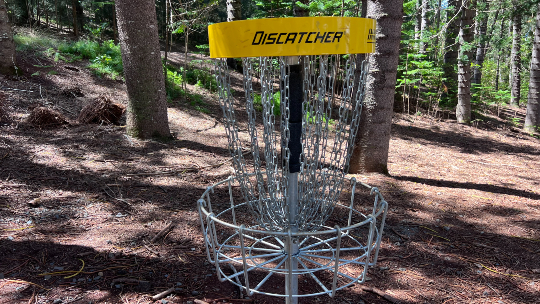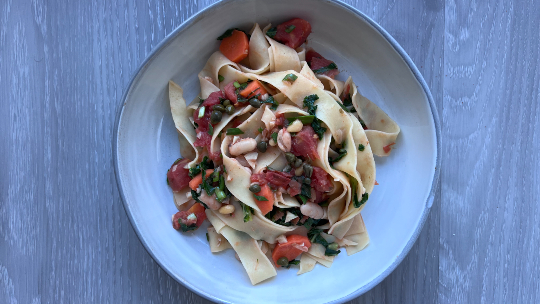Vanessa Houle was nervous the first time she put on her bee suit. Buying the crisp white suit and wearing it were two very different things. For one thing, it’s hot in there. For another, she could get stung. She walked up to the first hive she’d ever seen up close, which was under glass for observation. This was a far cry from seeing a bee or two in her garden.
What had she gotten herself into?
“To be up close and personal in a hive, their home, can be overwhelming,” says Houle. “They’re buzzing all around and you’re just kind of immersed in this world. It was an incredible thing to watch them all so busy and not even paying us any attention.”
There was no turning back. She was becoming a beekeeper.
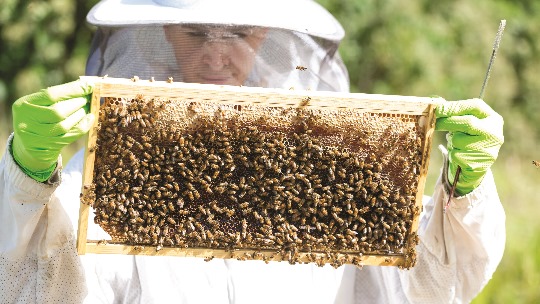
Getting buzzed
On a typical day, Houle is up before the sun hits the entrances to her 75 hives. Soon her bees will be up and out looking for food. She inspects 15-20 hives each morning, checking the queen’s health, seeing whether the bees have grown, built more comb, or need more space. Some days she harvests honey, other days are for pest control and yardwork.
Houle learned the trade from the local beekeeper who showed her the glass-covered observation hives 10 years ago. She was growing fruits and vegetables in her garden at the time and her plants were producing flowers but no fruit. She needed bees to pollinate them. “It’s been quite rewarding,” she says. “You’re raising your own bees, you’re pollinating your own fruits and vegetables, you’re helping pollinate the entire neighborhood.”

Today, Houle is secretary of the Big Island Beekeeper’s Association (BIBA), which she says is a great resource for anyone interested in beekeeping. “We try to increase awareness of the industry because people think bees are important, but they don’t really grasp it,” says Houle. “It’s not something you’re thinking about all the time, but they play a vital role in our food supply.”
Bees are responsible for one in every three bites of food we eat. In fact, 80% of food production on the Big Island relies on honeybee pollination. Commercial industries like coffee and macadamia nuts, which need hundreds or thousands of hives, rely heavily on them. So do local farmers who grow and sell avocados, lilikoi, and guava. So does Houle, who sells honey, makes beeswax food wraps, and hopes to open a honey winery.
Bees are essential to Hawai'i’s food security, but some backyard beekeepers are seeing benefits beyond sustenance. “It’s actually quite therapeutic for people,” says Houle. “There’s something about the humming of the hive and just watching the bees work that absorbs all of your senses. They just know what to do. It’s a very full-circle feeling having them present in your yard.”
Interested in beekeeping? Learn more about beekeeping on the Big Island.
Hilo honey
The University of Hawaii at Hilo is home to a 110-acre farm, which houses about 40 beehives. It’s the only school in the state that offers a beekeeping certificate. Professor Lorna Tsutsumi says the program, which has been around for 30 years, teaches students how to take care of honeybees and helps people understand their importance in growing the food that we eat. Without honeybee pollination, many cultural and traditional foods that shape our way of life would simply not exist.
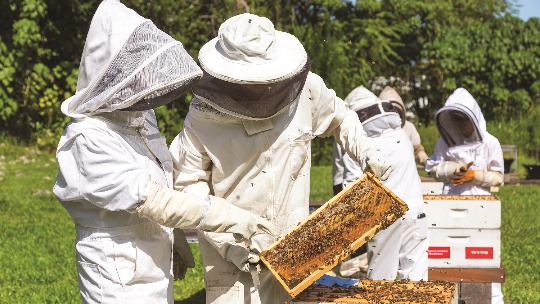
Beekeeping brings together students from culinary arts to agriculture to pre-veterinary. Ariana Dolan is one of those students. She’s wanted to be a vet since she was a child watching her grandmother take care of her diabetic cat. Since then, she’s worked in veterinary offices and with farm animals, but working with bees was new to her.
“I was kind of nervous, but I was also excited to try a new experience,” says Dolan. “Beekeeping was very different to me than my usual animal classes. I found it to be a lot more interesting. I was really engaged in it.”
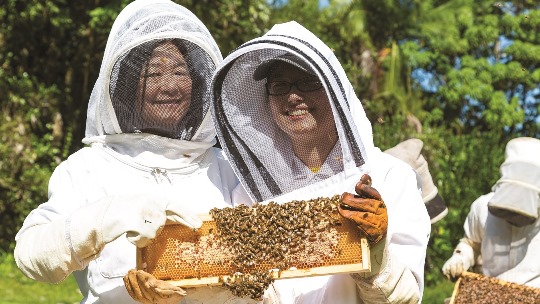
Beekeeping isn’t a requirement for pre-vet students, but in 2017 the Food and Drug Administration decided that veterinarians can prescribe antibiotics to bee colonies. Dolan took the course to bolster her transcript but found that it quickly became her favorite class. She’s taken both introductory and advanced beekeeping. Now she’s working on her beekeeping certificate.
Dolan says she’s still interested in a small animal practice but working with bees has opened her eyes to the possibility of assisting beekeepers in Hawaii.
Chef Alan Wong partners with UH Hilo in their Adopt-a-Beehive program. Try his recipe for sweet potato lemonade.
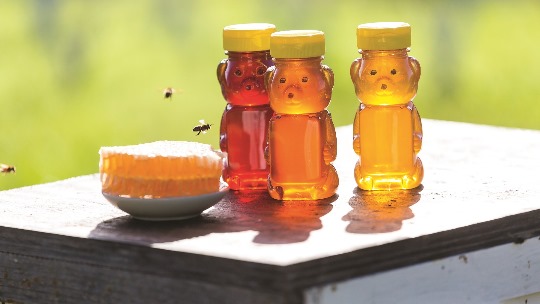
Beekeeping by the numbers
- Hawaii’s annual bee-pollinated crop sales add up to $212 million.
- There are about 15,000 hives in Hawaii.
- 90% of those hives are on the Big Island.
- Hawaii's honey production totaled $3.2 million in 2018.
- Hawaii supplies 25% of the queen bees on the Mainland and 75% of those in Canada.
Photos: Rae Huo

